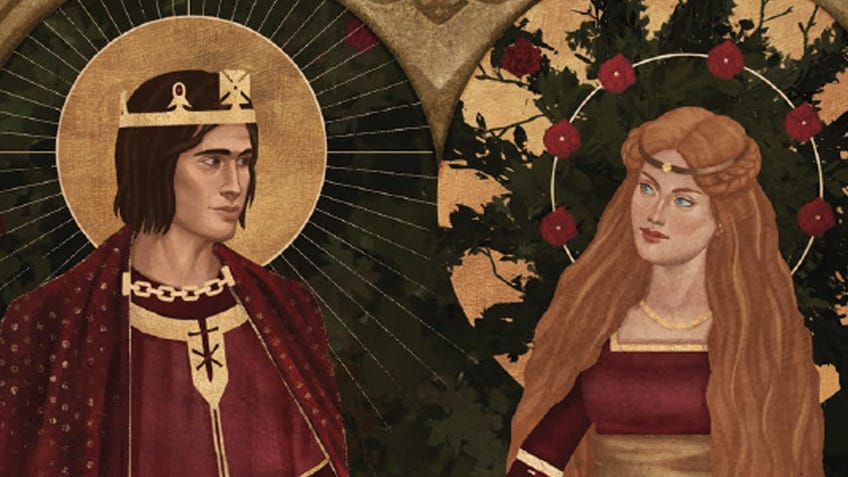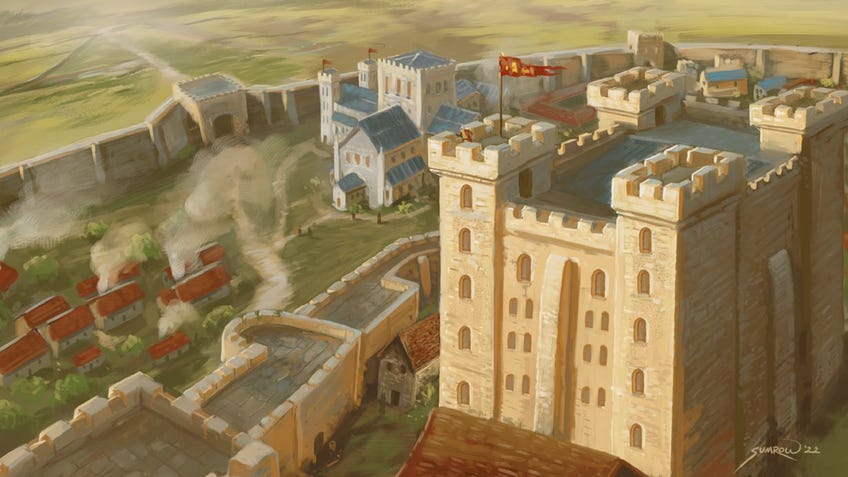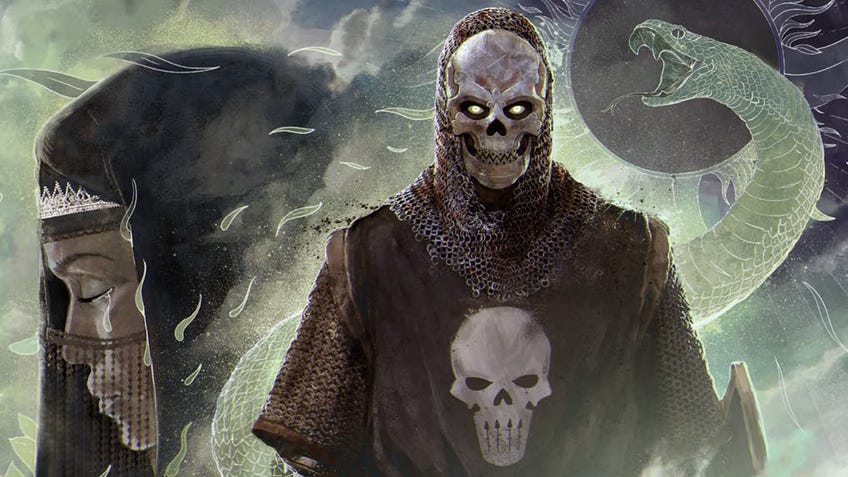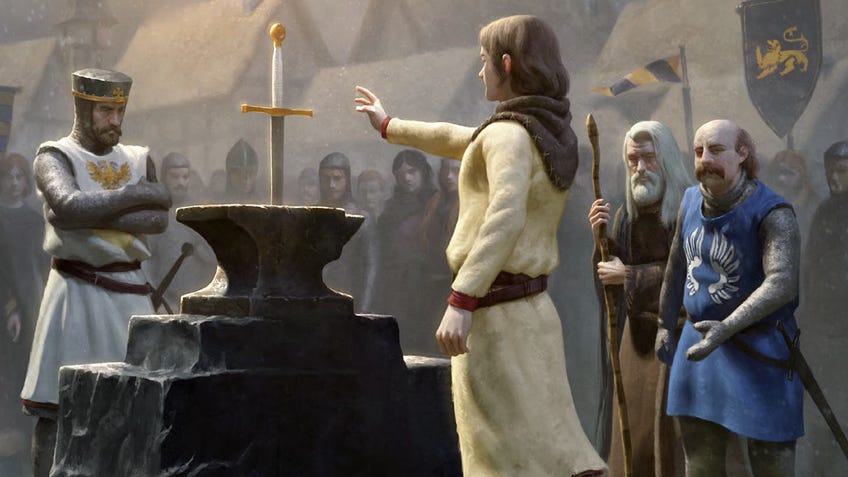‘The hobby is only just catching up to what Greg did 40 years ago’: Pendragon 6E, ‘ultimate’ edition of an RPG legend’s masterpiece, reclaims its crown
Return of the King.
The golden age of tabletop roleplaying has seen Dungeons & Dragons go from controversial subject of moral outrage and underground favourite played infamously in basements and back-alley comic shops to a pop-culture mainstay and divisive titan of the gaming industry with Hollywood fans, a blockbuster movie and the biggest video game of last year.
While D&D’s ongoing rise means that creators Gary Gygax and Dave Arneson are now more likely than ever to be familiar names outside of the hardest of hardcore fans, another late icon of fantasy roleplaying’s early days still remains lesser-known outside of dedicated hobbyists - despite arguably deserving just as much recognition for his visionary and influential contributions to tabletop roleplaying over the last 40-plus years. An upcoming new edition of Greg Stafford’s King Arthur Pendragon, the definitive version of the designer’s magnum opus, may help change that.
Even those who do recognise Stafford’s name may not know Pendragon. Stafford is typically widely recognised for co-creating RuneQuest, the mythological fantasy RPG released a handful of years after Dungeons & Dragons and set in his grand world of Glorantha. With its first edition second only to Advanced D&D in the sales charts before its decline in the mid-eighties, RuneQuest has seen several new editions since the turn of the millennium, most recently seeing an update in 2018’s RuneQuest: Roleplaying in Glorantha.
While RuneQuest is Stafford’s best-known work, however, it’s King Arthur Pendragon that many - including the designer himself - consider to be his best work.
“In the past, I have designed or co-designed seven published roleplaying games, five published board games, and one computer game, as well as innumerable supplements, adventures, and scenarios, and without a doubt King Arthur Pendragon is my favourite. I consider it my masterpiece,” Stafford wrote plainly in the designer’s notes to Pendragon’s fifth edition, released in 2005.
I have designed or co-designed seven published roleplaying games, five published board games and one computer game, and without a doubt King Arthur Pendragon is my favourite. I consider it my masterpiece.
Pendragon took Arthurian legend as its springboard for epic, character-centric roleplaying. Players were glory-seeking knights, but battled as much with their morals and motivations as with evil sorcerers or dragons. At the heart of the game were characters’ traits and passions, Stafford’s innovative way of creating complex and individual personalities. Traits pulled knights between contrasting characteristics - merciful or cruel, modest or proud, trusting or suspicious - while passions guided the characters’ behaviour according to deep-set beliefs and emotions, whether loyalty, love, hatred or something else entirely. The pioneering system was later introduced to RuneQuest, still largely unequalled almost four decades after it envisioned a new way of creating richly-detailed and humanly multifaceted characters.
“As I see it, Pendragon was so far ahead of its time the hobby is just now catching up to Greg’s innovations from nearly 40 years ago, so there really wasn’t much need to change things mechanically in any significant way,” says David Larkins, the line editor for Pendragon’s upcoming sixth edition.

The depth of Pendragon’s characters is matched by the scope of their stories, which - in true Arthurian fashion - can span many generations. In keeping with Stafford’s vision of a literary RPG, ongoing campaigns veer from the epic to the everyday as knights return between quests, pursuing romance, maintaining their home and eventually having a family with an heir to whom they can pass down their sword once they are too old to adventure.
“The game began as an imitation of a mythic genre, and I take great pride in how well it presents the literary and medieval world, warts and all,” Stafford writes in the sixth-edition Player’s Handbook. “In the literature, there is a struggle between the harsh reality of the medieval world and the bright idealism of the Round Table. That conflict is central to the game.”
For a game about embarking on decades-long quests, Pendragon has been on its own epic and eventful journey. The game’s first edition was released by Stafford’s publishing label Chaosium in 1985, which had followed RuneQuest with seminal horror RPG Call of Cthulhu. A planned second edition, split into three separate books, was cancelled before release (despite rumours of existing copies that Stafford himself denied) as the company shifted away from boxed products. Instead, a third edition followed in 1990, with a fourth edition in 1993.

Third Edition would be Chaosium’s last release for the game in almost two decades as Pendragon changed hands multiple times in the intervening years, leading to a stripped-back fifth edition - the game’s last major revision - just over a decade later from Vampire: The Masquerade maker White Wolf. After two incremental updates to Fifth Edition and another brief change of hands to Nocturnal Media, Pendragon finally returned home to Chaosium in late 2018, shortly after Stafford’s death that October. In 2020, the studio announced its plans to release Pendragon’s sixth edition, which Stafford had been working on for the decade before his passing and considered the “Ultimate” form of his masterpiece. (“It will be my last version, simply because my age requires me to work on new material, not to revise the old,” the designer writes with tragic foresight in the book’s notes.)
“One of the things I love most about Greg Stafford’s work is his commitment to the maxim of making the kind of game he wanted to play. Then you put it out there and see how many folks feel the same way,” Larkins says. “That’s why we call Sixth Edition Greg’s ‘Ultimate’ edition - actually a term he coined.
“I remember discussing bringing in mechanics from other games during the early development phases, but he wanted to tweak what was already there rather than make any significant changes. The system does what he wants it to, and it’s simply been a matter of adjustments and tweaks.”

When Stafford passed away, he left behind a draft of Sixth Edition totalling more than 500 pages. The “nearly complete” outline included minor reworks of many existing rules and lore, alongside brand new systems for battles and sieges. While the Chaosium team ‘polished’ the final books from the draft, Larkins assures that preserving Stafford’s distinctive voice was paramount.
“Everything you’ll read in the core books is fundamentally Greg’s writing,” Larkins says. “A great example of Staffordian prose, for example, is Greg’s definition of Knightly Skills: ‘Certain Skills are required for the office of knighthood. Few knights master them all. They mostly deal with finding, identifying, and killing people in a variety of ways, as politely as possible.’”
Playing Pendragon can feel quite different from a typical RPG.
Many of the biggest changes address how the rules are presented, rather than the rules themselves, aiming to provide a less intimidating first experience for newcomers. This resulted in the sixth edition’s core rules being broken into three separate books focused on distinct elements: a Player’s Handbook, Gamemaster’s Handbook and Noble’s Handbook. The core books follow a set of quickstart rules released in 2020, including the first printing of The Adventure of the Great Hunt, a scenario originally outlined by Stafford in 1991, and a starter set released last year. Classic adventures, such as Stafford’s acclaimed The Great Pendragon Campaign, which spans close to a century of in-game time where each year can form its own lengthy quest, will similarly be condensed into more easily-digestible volumes.
“Pendragon is quite simple, mechanically speaking, but the deep lore and high concepts can potentially be off-putting to someone unfamiliar with the Arthurian tales or the type of narrative tension and drama which the Traits and Passions system creates,” Larkins acknowledges. “Playing Pendragon can feel quite different from a typical RPG sometimes.
“Before [becoming line editor], as a fan and contributor to the line, too often I saw people start their Pendragon journey by jumping into The Great Pendragon Campaign with the intention of running the whole thing, only for things to fizzle before they even got to Arthur drawing the sword from the stone!”
Other changes in sixth edition look to modernise the game without departing from its setting’s dedication to a medieval experience. While non-male knights had been included as playable characters and NPCs from the start, the new edition increases representation for non-male characters and makes adjustments to rules for aspects such as inheritance and childbirth. (Stafford cites Sixth Edition’s expanded representation of women-at-arms in historical and literary sources to head off any questions over historical “purity”.)
“Non-male knights have been acknowledged as a character and setting option since first edition. But the thing is, they weren’t well represented in the art or scenarios, and things like inheritance tended to default to an assumption everyone would be playing men,” Larkins says, adding that Sixth Edition was developed with a team of designers, writers and artists representing “a diverse range of gender identities, sexualities, and cultural and religious backgrounds”. “So a lot of that kind of work on Sixth Edition was simply making sure the stated option of playing non-male knights had some actual support in the text and the art.”
Tragedy, an ever-present theme in the game, is now foregrounded.
Pendragon re-emerges into a fantasy landscape vastly different from that of 1985, or even its last full edition. With so much of modern fantasy - and pop-culture as a whole - seemingly undercut with a more cynical edge than the shining armour and pure-hearted aims of old, Pendragon’s sixth edition likewise leans further into the darker elements of its traditional inspirations.
“If you look at the first-edition box cover, the subtitle is ‘The Game of Quest, Romance, & Adventure’. Greg changed that for Sixth Edition; it is now ‘The Role-playing Game of Valor, Honor, and Tragedy’,” Larkins points out.
“I’m not saying 1985 was any kind of golden age, but it’s pretty undeniable that things can seem pretty dark these days in comparison, including in fantasy media. Everything is murky earth tones, every story has an undercurrent of evil on the brink of triumph. And so we see that subtle shift even in Greg’s description of the game - tragedy, an ever-present theme in the game, is now foregrounded.”

While Pendragon is no stranger to tragedy - the legends of King Arthur that it emulates end with many of the Round Table dead, Arthur mortally wounded in battle with Mordred and his kingdom doomed to ruin - the RPG balances its darkness with the hope that goodness will ultimately prevail.
“One of my favourite pieces of Greg’s writing in Sixth Edition is a short essay called ‘Bringing the Light’,” Larkins says. “In it, he talks about the dark, cruel world of Medieval Europe, and how Pendragon allows us to play in a world that is like that, but with the very real possibility of change for the better.”
Finding light in dark times may strike a chord with many people in 2024, amidst war, genocide, economic instability, environmental anxiety and in the lasting shadow of a deadly global plague. In many ways, the confident return of Pendragon after decades finding itself feels like the mythical resurrection of King Arthur himself.
We need something to feed our imaginations and our souls. I have striven to offer this food for the spirit through roleplaying games.
“There are so many themes in Pendragon that are more relevant now than ever, but fundamentally: who wouldn’t want to be a Big Damn Hero if given the chance?” Larkins says. “That’s why I play, and I think a lot of folks are looking for that sort of fun escapism.”
Just as his vision for what a roleplaying game could be was ahead of its time 40 years ago, Stafford himself seems blessed with the foresight of knowing his greatest work would always have something to offer its players: goodness.
“We are not just creatures of the brain, but also of the heart and soul,” the designer writes of humanity in his sixth edition notes. “We still need something to feed our imaginations and our souls. I have striven to offer this food for the spirit through roleplaying games. The game is for the sake of that magic. Conscious fantasy is good for gaming. It is good for people. It is good for the world.”


